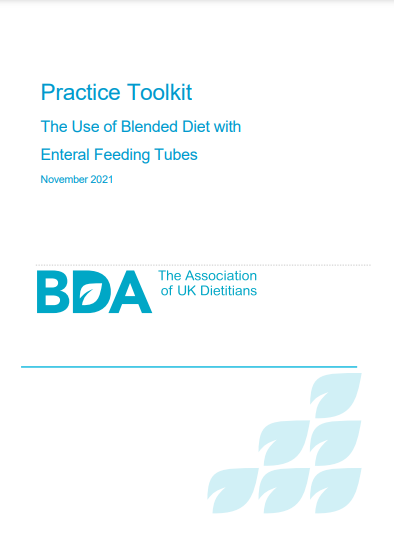
In April 2019, a working group was convened and funded by the Paediatric Group and the Parenteral and Enteral Group (PENG) of the BDA to review the BDA’s Policy Statement (2013) and Practice Toolkit (2015) in relation to the use of Blended Diet with Enteral Feeding Tubes.
The group represented both specialist groups and DISC (Dietitians Interested in Special Children). Group members all had considerable clinical experience of blended diet (acute and community dietitians and specialist paediatric nurse) as well as research interests on the topic.
Blended Diet is an umbrella term for a wide range of practices. Broadly speaking, blended diet can refer to any food or drink other than water, expressed breast milk, infant formula or commercial enteral formula being given via an enteral feeding tube.
In reality it varies from giving a small amount of puree or juice to using blends to meet full nutritional requirements. The practice has been contentious with some professionals expressing concerns over safety and adequacy; however, it is evident that dietitians in clinical practice have been successfully supporting patients to safely use blended diet, particularly in the speciality of Home Enteral Tube Feeding (HETF).
Considerable benefits have been noted in the literature such as reduction in reflux, retching and vomiting and improved bowel habit. Social and emotional benefits are also evident as families are able to make food choices and share the same everyday foods.
Where the 2013 Policy Statement had suggested dietitians should support patients who had chosen blended diet, the 2019 Policy Statement went a step further and suggested that blended diet may be offered as a choice to patients and carers as an option by the dietitian.
In the new practice toolkit a shared-decision approach, as recommended by NICE, rather than risk assessment approach is advocated.
As a relatively new area of dietetics, practical advice for dietitians was important to support the change in Policy Statement (2019). Work on the Practice Toolkit started immediately after publication of the Policy Statement (2019) with a view to publication in late 2020.
Unfortunately, the world changed rapidly due to the COVID-19 pandemic and members of the group, as with many NHS professionals, were pulled in directions other than their usual day-to-day work which resulted in a significant delay in publication of the Practice Toolkit.
Fortunately, the group adapted to working virtually on the project and after numerous MS Teams meetings and countless drafts and emails here it is!
The Practice Toolkit begins with a basic background to blended diet and the reasons why it could be considered by UK registered dietitians as an option in clinical practice (Section 2). Section 3 outlines the process used to develop the recommendations for clinical practice.
It should be highlighted that, despite a marked increase in popularity, blended diet remains under-researched. Relevant literature was identified, however in the main papers focused on either professional experience or a particular aspect of blended diet under laboratory conditions and so are limited.
For this reason, the suggested good practice provided in the Practice Toolkit draws also on the expert opinion of UK dietitians and other healthcare professionals working in the field of HETF who have experience supporting patients and families to use blended diet. The Practical Recommendations made in Section 4 are subdivided by topic with a view to a dietitian in clinical practice being able to quickly navigate to a particular area of interest.
Summary boxes have also been used at the end of each Sub-Section. Finally, in the Appendices, resources have been included which can be adapted for local use and further useful sources of information have been identified.
It is envisaged dietitians who are new to blended diet will be able to use this Practice Toolkit as a starting reference but alongside should seek the support and supervision from an experienced colleague, as would be expected in any new specialist area.
It is hoped this Practice Toolkit will help tube fed individuals and their families to receive effective, equitable and quality care. We would like to thank all the families, clinicians and academics who gave up their time and contributed by commenting on drafts and made suggestions to improve the text.
This document is an evolving work in progress and the BDA welcomes feedback and encourages further discussion and research on the topic.



